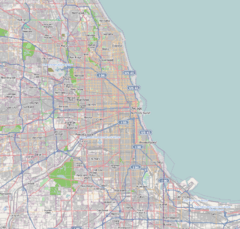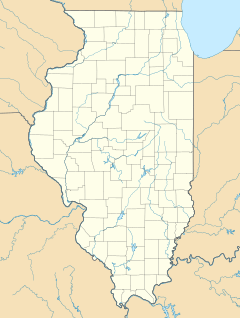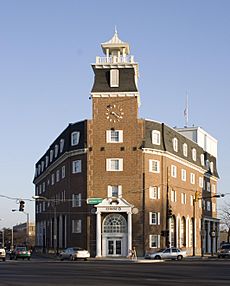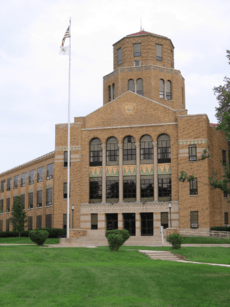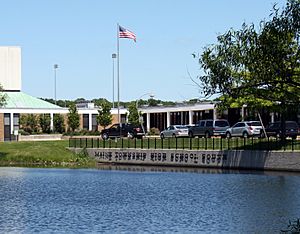Park Ridge, Illinois facts for kids
Quick facts for kids
Park Ridge, Illinois
|
|||
|---|---|---|---|
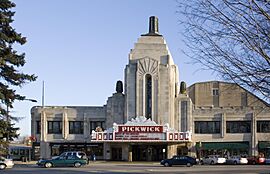
|
|||
|
|||
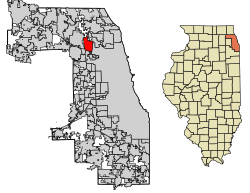
Location of Park Ridge in Cook County, Illinois
|
|||
| Country | United States | ||
| State | Illinois | ||
| County | Cook | ||
| Township | Maine, Leyden, Norwood Park | ||
| Incorporated | 1873 | ||
| Government | |||
| • Type | Council–manager | ||
| Area | |||
| • Total | 7.13 sq mi (18.48 km2) | ||
| • Land | 7.09 sq mi (18.36 km2) | ||
| • Water | 0.05 sq mi (0.12 km2) 0.56% | ||
| Population
(2020)
|
|||
| • Total | 39,656 | ||
| • Density | 5,594.81/sq mi (2,160.32/km2) | ||
| Down 0.8% from 2000 | |||
| Demonym(s) | Park Ridgian | ||
| ZIP code(s) |
60068
|
||
| Area code(s) | 847, 224 | ||
| FIPS code | 17-57875 | ||
Park Ridge is a city in Cook County, Illinois. It's a suburb located just outside of Chicago. In 2020, about 39,656 people lived there. It's about 15 miles north of downtown Chicago. It's also very close to O'Hare International Airport, major highways, and train lines.
Park Ridge is part of the larger Chicago metropolitan area. It borders Chicago neighborhoods like Edison Park, Norwood Park, and O'Hare. The city's soil has a lot of clay. This made it a key place for making bricks for Chicago as it grew. Park Ridge was first called Pennyville, named after George Penny, who owned a brickyard. Later, it was known as Brickton. The Des Plaines River separates Park Ridge from its neighbor, Des Plaines, to the west. Chicago is to the south and east, while Niles is to the north.
Contents
History of Park Ridge
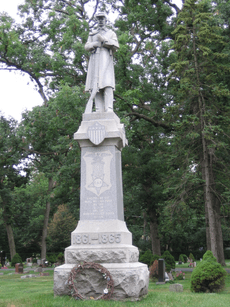
The land where Park Ridge now stands was once home to the Potawatomi people. They lived there until 1833. The area was a useful spot for French explorers to carry boats between the Des Plaines and Chicago rivers. In the early 1830s, the first settlers arrived from New England and New York.
In 1854, George Penny started a brick-making business in the area. Because of the brickworks and the large amount of clay, locals called Park Ridge "Brickton." The city's population grew steadily over the years. In 1910, about 2,009 people lived there. By 1930, the population had grown to 10,417. In 1950, it was 16,602, and by 1960, it reached 32,625.
In 2016, Hillary Rodham Clinton, who graduated from Park Ridge's Maine Township High School South in 1965, ran for President of the United States.
Park Ridge Geography and Climate
Park Ridge covers a total area of about 7.14 square miles (18.48 square kilometers). Most of this area, about 7.09 square miles (18.36 square kilometers), is land. Only a small part, about 0.05 square miles (0.12 square kilometers), is water.
Understanding Park Ridge's Climate
Park Ridge is in the USDA 5b Plant Hardiness zone. This zone helps people know which plants can survive the winter temperatures.
| Climate data for Park Ridge, Illinois | |||||||||||||
|---|---|---|---|---|---|---|---|---|---|---|---|---|---|
| Month | Jan | Feb | Mar | Apr | May | Jun | Jul | Aug | Sep | Oct | Nov | Dec | Year |
| Record high °F (°C) | 67.0 (19.4) |
75.0 (23.9) |
88.0 (31.1) |
91.0 (32.8) |
98.0 (36.7) |
104.0 (40.0) |
105.0 (40.6) |
102.0 (38.9) |
101.0 (38.3) |
94.0 (34.4) |
81.0 (27.2) |
71.0 (21.7) |
105.0 (40.6) |
| Mean daily maximum °F (°C) | 30 (−1) |
35 (2) |
46 (8) |
58 (14) |
70 (21) |
79 (26) |
84 (29) |
81 (27) |
74 (23) |
62 (17) |
47 (8) |
34 (1) |
58 (15) |
| Mean daily minimum °F (°C) | 14 (−10) |
19 (−7) |
29 (−2) |
38 (3) |
47 (8) |
63 (17) |
62 (17) |
54 (12) |
42 (6) |
42 (6) |
32 (0) |
20 (−7) |
39 (4) |
| Record low °F (°C) | −27.0 (−32.8) |
−21.0 (−29.4) |
−12.0 (−24.4) |
7.0 (−13.9) |
27.0 (−2.8) |
35.0 (1.7) |
45.0 (7.2) |
42.0 (5.6) |
29.0 (−1.7) |
14.0 (−10.0) |
−2.0 (−18.9) |
−25.0 (−31.7) |
−27.0 (−32.8) |
| Average precipitation inches (mm) | 1.73 (44) |
1.87 (47) |
2.50 (64) |
3.38 (86) |
3.68 (93) |
3.45 (88) |
3.7 (94) |
4.9 (120) |
3.21 (82) |
3.15 (80) |
3.15 (80) |
2.25 (57) |
33.82 (859) |
| Source: <Park Ridge, Illinois Weather= > | |||||||||||||
Park Ridge Population and Demographics
| Historical population | |||
|---|---|---|---|
| Census | Pop. | %± | |
| 1880 | 457 | — | |
| 1890 | 987 | 116.0% | |
| 1900 | 1,340 | 35.8% | |
| 1910 | 2,009 | 49.9% | |
| 1920 | 3,383 | 68.4% | |
| 1930 | 10,417 | 207.9% | |
| 1940 | 12,063 | 15.8% | |
| 1950 | 16,602 | 37.6% | |
| 1960 | 32,659 | 96.7% | |
| 1970 | 42,614 | 30.5% | |
| 1980 | 38,704 | −9.2% | |
| 1990 | 36,175 | −6.5% | |
| 2000 | 37,775 | 4.4% | |
| 2010 | 37,480 | −0.8% | |
| 2020 | 39,656 | 5.8% | |
| U.S. Decennial Census 2010 2020 |
|||
As of the 2020 census, Park Ridge had 39,656 people living there. There were 14,384 households and 10,323 families. The population density was about 5,558 people per square mile.
The city's population was mostly White (86.10%). Other groups included Asian (4.87%), African American (0.53%), and Native American (0.16%). About 7.20% of the population identified as Hispanic or Latino.
About 32.2% of households had children under 18. Most households (59.61%) were married couples. The average household had about 3.11 people. The average family had about 2.56 people.
The median age in the city was 45.2 years. About 23.5% of the population was under 18. About 20.3% were 65 or older.
The median income for a household in Park Ridge was $113,809. For families, the median income was $145,995. About 3.9% of the population lived below the poverty line.
Economy and Top Employers
Park Ridge has a strong economy with several large employers. These businesses provide many jobs for the community.
Major Employers in Park Ridge
According to a 2020 report, these are some of the top employers in the city:
| # | Employer | # of Employees |
|---|---|---|
| 1 | Advocate Lutheran General Hospital | 3,693 |
| 2 | Maine Township High School District 207 | 975 |
| 3 | Park Ridge Park District | 813 |
| 4 | Park Ridge-Niles School District 64 | 700 |
| 5 | City of Park Ridge | 350 |
| 6 | Presence Resurrection Health Care | 332 |
| 7 | FM Global | 300 |
| 8 | Mariano's Fresh Market | 276 |
| 9 | Advocate Medical Group | 250 |
| 10 | Park Ridge Community Bank | 225 |
Arts and Culture in Park Ridge
Park Ridge is known for its unique cultural spots.
The Historic Pickwick Theatre
The most famous landmark in Park Ridge is the Pickwick Theatre. This beautiful Art Deco building was built in 1928. It serves as both a movie theater and a place for plays and concerts. In 1975, it was added to the National Register of Historic Places. The main theater can hold up to 800 people. Its unique front was even used in the opening credits of the TV show At the Movies in the 1980s.
Park Ridge Public Library
The city is also home to the Park Ridge Public Library. It offers books, resources, and programs for everyone in the community.
You can find more about the city's historic landmarks and old homes on the City of Park Ridge Historic Preservation Commission's website.
Education in Park Ridge
Park Ridge has excellent schools for students of all ages.
Elementary and Middle Schools
The Park Ridge-Niles School District 64 serves the city. This district includes:
- Lincoln Middle School
- Emerson Middle School (in Niles)
- Five public elementary schools: Carpenter, Field, Franklin, Roosevelt, and Washington.
- Jefferson School, which helps preschool children with special needs.
After-school programs for younger students are offered by the Park Ridge Park District.
There are also private schools:
- St. Paul of the Cross (Catholic elementary)
- Mary Seat of Wisdom (Catholic elementary)
- St. Andrews (Lutheran elementary)
High Schools in Park Ridge
Students in Park Ridge attend high schools within the Maine Township High School District 207. These include:
- Maine South High School
- Maine East High School
Students in northern Park Ridge can choose to attend either Maine East or Maine South. Maine West High School is located nearby in Des Plaines.
The district also has student-run radio and television stations called WMTH-FM. Famous actor Harrison Ford, known for movies like Indiana Jones and Star Wars, went to Maine East. He was even the radio station's first sports announcer!
Higher Education
Park Ridge is part of the Oakton Community College district. This college offers many programs for students after high school.
Transportation Options
Getting around Park Ridge and to other cities is easy thanks to various transportation options.
Train Services
The Park Ridge station and Dee Road station offer Metra commuter rail service. These trains run along the Union Pacific Northwest Line. You can travel southeast to Ogilvie Transportation Center in Chicago or northwest to places like Harvard or McHenry station.
Bus Services
Pace provides bus service with many routes connecting Park Ridge to different areas. The CTA also operates the Route 68 bus, which goes directly to Chicago.
Famous People from Park Ridge
Park Ridge has been home to many well-known individuals.
- Hillary Rodham Clinton: She grew up in Park Ridge. In 1997, when she visited for her 50th birthday, a corner near her childhood home was renamed "Rodham Corner." She graduated from Maine South High School.
- Movie Stars: Carrie Snodgress, Karen Black, Suzanne Snyder, and Harrison Ford all grew up in Park Ridge. They all attended Maine Township High School East.
- Sean Giambrone: Known for his role as Adam in The Goldbergs, he also grew up in Park Ridge. He attended Lincoln Middle School and Maine South High School.
- Mother Frances Cabrini: The first U.S. citizen to become a saint, she attended St. Paul of the Cross Church and owned a farm in Park Ridge.
- James Pankow: A founding member of the rock band Chicago, he is a talented trombone player and songwriter.
- Grant Wood: This famous artist once owned a shop and lived in Park Ridge.
Sister City
Park Ridge has one sister city, a partnership formed in 1998:
- Kinver, Staffordshire, England
See also
 In Spanish: Park Ridge (Illinois) para niños
In Spanish: Park Ridge (Illinois) para niños




